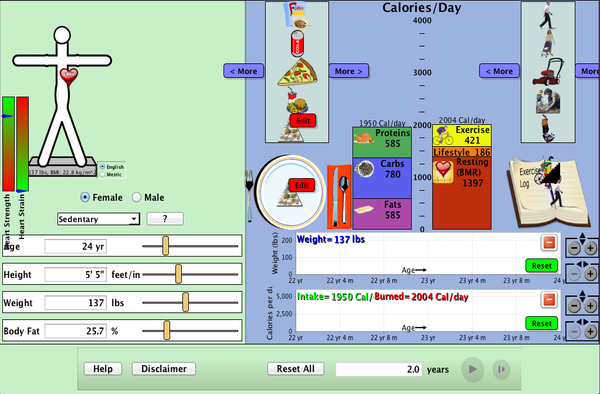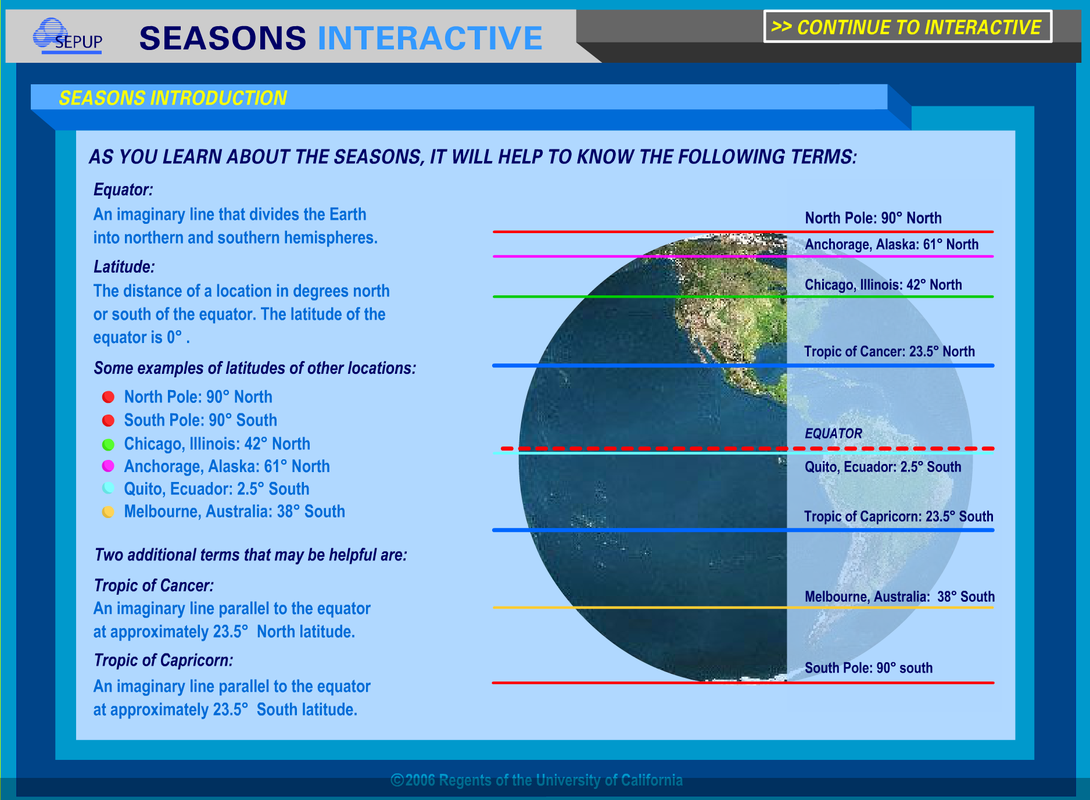Science/Math
Learning Activities
This page provides analysis of a variety of Science and Mathematics technological activities which can be integrated into the sixth grade curriculum and aligned with English/Language Arts content standards.
Explore Learning Gizmos
|
phet: Eating and Exercise
Eating and Exercise
|
General Observations:
This simulation is part of the PHET website, which has interactive Science simulations created by the University of Colorado, Boulder. These simulations need to be downloaded to run on a computer. I was not able to run the program on my MacBook, but was able to do so on a Dell/Windows computer. Personal Reactions: This simulation explores the relationship between exercise and food consumption. It is a valid and appropriate subject to explore. The simulation runs quickly, however, and It is difficult to see how changing a variety of variables works. Ease of Use: The Eating and Exercise Simulation downloads to run. It worked on a Windows computer, but was not recognized on a Mac. There were quite a few variables to adjust, This was a bit confusing. The simulation ran quickly, but I think it might be difficult for a sixth-grade student to use, even though it was included in the middle-school grade level. Educational Value: Students explore and change different variables to examine their effects on health. Variables include types of physical activity, food choices, and age. These topics apply to health and physical education standards for students. Age/Developmentally Appropriateness: This topic is appealing to sixth grade students, as their body awareness and health is something they are becoming about which they are becoming aware. While they are appropriate to examine, 10-11 year old students in sixth grade may not appreciate implications on health of their choices due to their limited perspective. Observations related to the simulation's applicability to content area topic: In the book, Esperanza Rising, the characters have a limited diet of rice and beans, as well as some fruit and vegetables, based on what is affordable and in season. The limits of diet provide insights into struggles of characters in the book. Further, the physical exercise required of farm workers, and exposure to spores (in the case of Esperanza's mother) can affect health. Exploring health in the context of the Esperanza Rising connects it to students lives and makes it more relevant to them. |
Seasons Interactive Simulation
|
General Observations:
This simulation demonstrates the effects of the earths tilted rotational axis, rotation around the earth, seasonal light differences, and latitudinal differences. These elements are particularly important to farmers, who grow agricultural crops based on temperature and other weather conditions. Personal Reactions: While this simulation is simple to use, it does provide broader information about temperatures and weather conditions around the globe. The demonstration allows students to visually observe the impact of the earth's rotation around the sun. Ease of Use: The simulation is easy to use and observe. There are multiple elements that can be changed in the simulation, with which a student can experiment. Students can change one or many elements to observe effects of changes of time of year, place on the globe, or tilt of the earth. Educational Value: The Sixth Grade NGSS Integrated Model Standards call for students to understand both the water and weather on the Earth's surface. The following standards, ESS2.C: The Roles of Water in Earth’s Surface and Processes and ESS2.D: Weather and Climate, call for students to explore these topics. This exploration can be done using this simulation in conjunction with reading the book, Esperanza Rising. Age/Developmentally Appropriateness: This interactive model provides an engaging and age-appropriate learning opportunity for students to explore their understanding of the effects of the Earth's daily rotation and annual revolution around the sun on weather and seasons. The model is simple, but allows for students to change multiple elements and explore how they affect seasons. Observations related to the simulation's applicability to content area topic: The novel, Esperenza Rising, examines the lives of Mexican immigrants who come to California during the 1920's to work on farms. The characters pick and package fruit and vegetables which are greatly affected by water, weather, and seasons. Coupling the study of the earth with the book, deepens students' understanding of the book and the effects of weather on the characters and plot. The dust storms of the time are featured and can be explored in terms of their impact on the earth, as well as on the characters in the book. |
DESMOS Water Line Estimation activity
Desmos - Water Line
|
General Observations:
Water use is critical to farmers and agricultural workers. This simulation provides the opportunity for students to explore predicting the measurement of water using a graph. Further, deeper mathematical thinking is required and problem-solving skills are developed when students are required to graph water use using different measurement vessels. Personal Reactions I enjoyed playing with this tool. It required estimation and iteration to graph correctly. The site provides for deeper understanding as a student gains experience using the graphing feature. Ease of Use: The concepts are visually appealing, and easy to use. However, the first time I plotted points on the water level/time on graph, I was not completely correct. This caused me to redo the estimation process multiple times until I was able to correctly plot the points. This error analysis and required iteration made the tool easy to use, but also enhanced learning. Educational Value: Students will plot water added based upon the type of vessel or container water is added to. This is an exploration activity for students and is applicable to farmers who use water for plants. Age/Developmentally Appropriateness: The activity description on the Desmos site identifies this as designed for Algebra students or "Students who have thought about relationships between stories and graphs before." Most sixth grade students are not yet taking Algebra. However, the exploratory nature of this simulation makes the mathematical understanding accessible to sixth grade students. Observations related to the simulation's applicability to content area topic: Water is a critical resource for farmers. The agricultural workers in the novel, Esperanza Rising, needed water for the plants they harvested and processed. They were also affected by dust storms. This water graphing activity provides students the opportunity to evaluate water flow based on different containers. |
Science/Math Resources
|
Resource: Estimation 180:
Link to Subject Matter content: Estimation 180 supports student development of Numbers Sense by making estimates over 180 days. The first day is quite simple, and the estimations get more complex over time. The characters in Esperanza Rising made decisions based upon their own understanding and predictions. The characters emigrated from Mexico to the United States because they thought they would make more money. Esperanza saved money to bring her grandmother to the U.S.A. Each of these estimates required characters to have estimation and number sense skills, which students could practice with Estimation 180. Students could create their own Estimation 180 pictures or activities based on events in the book. Resource: Would You Rather: Link to Subject Matter content: The characters in Esperanza Rising had complex decision to make. Should they strike or not strike? Should Esperanza support Marta who wanted to strike or not. Decision-making skills get better with practice. The decisions on the Would You Rather site provide much needed practice for students. Students could extend learning by developing Would You Rather situations that the characters faced and argue for a variety of outcomes. Resource: Visual Patterns: Link to Subject Matter content: Esperanza and her family processed and packed fruits and vegetables. This required that they had visual patterning skills for counting, packing, and packaging the products. The Visual Patterns site provides practice with this skill. Students could develop visual patterns based upon challenges that the characters faced or create visual patterns using fruits and vegetables that were in the book, Esperanza Rising. Resource: Open Middle: Link to Subject Matter content: The Open Middle questions relate directly to Common Core Mathematics standards. Practicing concepts with real world problems. Characters in Esperanza Rising also had to solve real world challenges, so practicing grappling with issues aligns with concepts identified in the book. Students could extend their learning by developing questions that meet standards using experiences that Esperanza faced in the book, for example regarding travel between Mexico and the United States by train. Resource: Science Kids: How Things Grow Link to Subject matter content: The How Things Grow interactive examines the growth of plants by varying elements. It is a bit simpler than the Explore Learning Gizmo cited above. Also, it is free! Still it certainly applies to deepening students understanding of plants, including the plants and vegetables that Esperanza and her family harvested. Students could deepen their understanding of what plants require to grow and thrive. This helps them better comprehend what Esperanza's family faced as migrant workers, dependent on plant growth for their livelihood. Resource: K-Science Animations Link to Subject matter content: Students can explore and label the parts of a plant cell to better understand the parts of a plant and how it grows using the How Plants Grow labeling activity. This activity supports the novel, as the characters in the novel were harvesting fruits and vegetables. Students could explore other biology animations, to get a better understanding of biological processes apply to the life of farm workers. Resource: Snow vs. Sleet vs. Rain Link to Subject matter content: Students know that weather affects the produce grown on a farm. This simulation shows how snow, sleet, and rain form as the fall through the atmosphere. Students could use this simulation to discuss how each of these type of precipitation would affect the plants and characters in the book, Esperanza Rising. Students could make predictions and do research on the effects of a variety of precipitation types on the different fruits and vegetables that Esperanza and her family processed. Resource: Edheads Link to Subject matter content: Edheads has several free simulations that are available. One which applies to Esperanza Rising is Trauma, as Esperanza's mother was very sick and in the hospital in the book. This simulation provides students the opportunity to explore what working in a hospital would be like. After completing this simulation, students could compare and contrast Esperanza's mother experiences in the hospital. Resource: Web Adventures in Science Link to Subject matter content: Medmyst is a series of simulations which allow students to explore infectious diseases. As there are multiple games to chose from, students could have some choice in which they would like to explore. They could use these simulations to think about Esperanza's mother illness. Students could use the simulations to make informed guesses about why she was sick and how she could get better. Resource: Yummy Math Best Deal on Candy Link to Subject matter content: This activity asks students to calculate the best deal on candy. When she went to to store, Esperanza bought candy and had very limited money. This activity allow students to look at buying candy that is the best deal, which is what Esperanza would have done. Additional Resources: Math Resources: Science Resources: |
Proudly powered by Weebly

